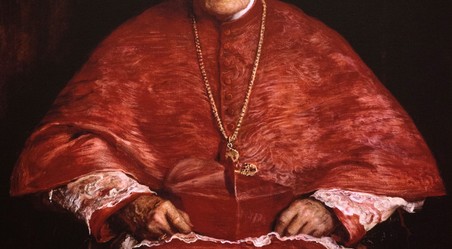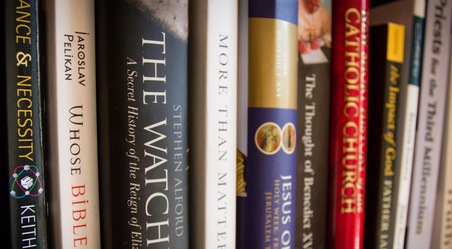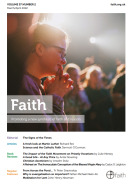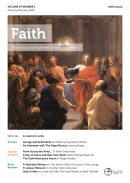Featured
May, Mary, and the Church Today
Christian courage in the face of persecution
The Synodal Way?
A Newman meditation for our country

Arise, Mary, and go forth in thy strength into that north country, which once was thine own, and take possession of a land which knows thee not. Arise, Mother of God, and with thy thrilling voice, speak to those who labour with child, and are in pain, till the babe of grace leaps within them! Shine on us, dear Lady, with thy bright countenance, like the sun in his strength, O stella matutina, O harbinger of peace, till our year is one perpetual May. From thy sweet eyes, from thy pure smile, from thy majestic brow, let ten thousand influences rain down, not to confound or overwhelm, but to persuade, to win over thine enemies. O Mary, my hope, O Mother undefiled, fulfil to us the promise of this Spring.
Carmelite Novices Formation Meeting: ‘Who do you say I am?’

Carmelite Novices Formation Meeting: ‘Who do you say I am?’
Stand-up comedy, books and a newspaper
Stand-up comedy, books and a newspaper
Holloway on… Looking at the problem of evil - Part I
Book Review: The Christian revolution that made our world

Book Review: The cry of a Cardinal’s soul
Book Review: Wisdom beyond monastery walls
-
May, Mary, and the Church Today
2020 marks the centenary of the birth of Karol Wojtyla, John Paul II.A standard media commentary on John Paul II’s Marian theology is to state that, as he lost his mother at a young age, his pious father encouraged him in devotion to the Virgin Mary, and thus began a lifelong attachment which revealed itself throughout his pontificate.This approach, even when adopted with a sense of respect for John Paul’s knowledge and wisdom, manages to convey a slightly patronising note.The reality is that, although John Paul’s devotion to Mary certainly owes much to the Marian piety in which he was reared – and the strength it brought to Poles during the terrible years of WWII and the Cold War – there is, much more importantly, a theological insight connecting Mary to the very nature of the Church. This is needed for our times. It was discussed at the Second Vatican Council, owes much to the work of theologians Hans Urs von Balthasar and Henri de Lubac – both influential at the Council – and is perhaps only now becoming better known and understood.Mary, Vatican II and the ChurchThe period immediately before the Council was strongly “Marian” in the Church, with the declaration of the doctrine of the Assumption by Pius XII in 1958, named a “Marian Year”. Images of Mary had been popular throughout the Church’s history, but a new genre had been created with the 19th century apparitions at Lourdes: a century later images of her as a young girl, a rose on her foot and a rosary in her hand, were everywhere in the Catholic world. The 1943 film “The Song of Bernadette”(1), popularised Lourdes at a time when there was a longing for a spiritual uplift, during and immediately after World War II. The apparitions at Fatima in 1917 included a message calling for prayer and penance for “the conversion of Russia” and were linked to worries over the Cold War and the possibility of nuclear annihilation. Marian devotion was not seen as old-fashioned but was associated with confidence in the Church in a century that had seen two world wars and needed hope.At the Second Vatican Council, after much debate about a separate document on Marian doctrine, a final decision was to incorporate a specific section on Mary in the document on the Church. This proved to be something of great value.Archbishop Karol Wojtyla emphasised that the document should speak of Mary’s “motherhood” in the Church, a “maternal care that all the sons and daughters of the Church be conformed to Christ”.(2) He stressed urgency about this, noting that in the original draft of the document “the Church is presented to us more as a teaching society than as a mother”,(3) and that the Marian presence would correct this.This was all part of a new insight into the nature of the Church that had begun in the 19th century with a move away from the post-Reformation message that the Church was a “perfect society”, a structure with answers to every question and a formula by which all should live, towards an understanding of the Church as a communion, as the Bride of Christ, and also as his mystical Body. Pius XII had developed this in Mystici Corporis,(4) his wartime encyclical emphasising the Church as a loving reality offering a message of hope to a divided, angry and wounded world.Lumen GentiumThe document Lumen Gentium follows the language of Pius XII in speaking about the Church. It states:“Since the Church is in Christ like a sacrament or as a sign and instrument both of a very closely knit union with God and of the unity of the whole human race, it desires now to unfold more fully to the faithful of the Church and to the whole world its own inner nature and universal mission.”(5)Speaking of Mary, the document emphasises her role as subordinate to that of Christ: the tone speaks of a need to answer Protestant criticisms that Catholics worship Mary as a deity, and to reassure these critics that they have been heard and that their fears are groundless.Then comes an important paragraph in which the life and role of the Church are described, in language emphasising the unity between the Church and Mary:“The Church indeed, contemplating her [Mary’s] hidden sanctity, imitating her charity and faithfully fulfilling the Father’s will, by receiving the word of God in faith becomes herself a mother. By her preaching she brings forth to a new and immortal life the sons who are born to her in baptism, conceived of the Holy Spirit and born of God. She herself is a virgin, who keeps the faith given to her by her Spouse whole and entire. Imitating the mother of her Lord, and by the power of the Holy Spirit, she keeps with virginal purity an entire faith, a firm hope and a sincere charity”.(6)Mary, Mother of the Church: Paul VIIn closing the third session of the Vatican Council (November 21st 1964) Paul VI solemnly declared Mary to be “Mother of the Church”. In 1974 his Apostolic Exhortation Marialis Cultus noted that Marian devotion needed to emphasise, in accordance with the Church's tradition, that Mary should be imitated, “not precisely in the type of life she led, and much less for the socio-cultural background in which she lived and which today scarcely exists anywhere. She is held up as an example to the faithful rather for the way in which, in her own particular life, she fully and responsibly accepted the will of God (cf. Lk. 1:38), because she heard the word of God and acted on it, and because charity and a spirit of service were the driving force of her actions. She is worthy of imitation because she was the first and the most perfect of Christ’s disciples. All of this has a permanent and universal exemplary value”.(7)Enter John PaulPaul VI’s initiative was too often ignored. The arrival of John Paul II brought a strikingly “Marian” figure to the papacy. His understanding of Mary’s protective and prophetic role in the Church and in the life of every Christian came into spectacularly sharp focus when he was shot in St Peter’s Square on May 13th 1981. As he was rushed to hospital – he was very near to death – he was heard praying “Mary, my mother…”. Today, a marble slab in St Peter’s Square marks the spot, and a mosaic of Mary high on the Vatican wall carries the words “Totus Tuus”, commemorating his prayer.The fact that the assassination attempt took place on the Fatima anniversary seemed to involve John Paul in the drama of those apparitions.(8) His pondering of this would result in his consecration of the world to Mary with the world’s bishops in 1984 and the dramatic unveiling of the famous “Third Secret” in 2000. But there were other important aspects of his Marian devotion.Marian YearJohn Paul declared 1987–1988 a Marian Year, issuing an encyclical Redemptoris Mater, and an apostolic letter on women, Mulieris Dignitatem. But a particularly significant message in this Marian Year was his teaching on the “Marian profile” of the Church, launched with his address to the Roman Curia in December 1987.9 Here he discussed in detail the message of Lumen Gentium and Mary, declaring that Vatican II “effected a great synthesis between Mariology and ecclesiology”.(10) Quoting St Augustine and St Ambrose, he spelt out the bond between Mary and the Church, centred on her total openness to the will of God, and the way in which he role as mother and protectress flows from this. The Church must be like Mary, utterly and freely open to the will of God in every way: “The Virgin Mary is the archetype of the Church because of the Divine maternity; just like Mary the Church must be, and wishes to be, Mother and Virgin. The Church lives in this authentic ‘Marian profile’, this ‘Marian dimension’”.(11) And this “Marian profile”, he taught, precedes the Petrine profile: the Church is not essentially a structure, it is a great “yes” to Christ.This brings a crucial insight to the reality of the Church, expanding and explaining the teaching in the Marian section of Lumen Gentium. It is one that is essential for clergy and laity alike to grasp, and is perhaps of particular importance for anyone working in what could perhaps be called the Church’s bureaucracy, or “Civil Service”. As one lay commentator notes:“Speaking to men who understood themselves to be working at the centre of the world’s Catholic reality in Rome, the Pope reminded his curial collaborators that the Petrine Church of authority and jurisdiction they embodied, like the Pauline Church of proclamation and evangelisation, and the Johannine Church of contemplation and prayer, takes its purpose and meaning from the prior and even more fundamental Marian Church: the Church formed in the image of a woman, Mary, whose assent to Gabriel’s message in Luke 1.38 was the first act of Christian discipleship, in that it made possible the incarnation of the Son of God.”(12)UnderstandingFrom where did John Paul get this understanding of the pre-eminence of the Marian profile of the Church? From the Scriptures – her assent in Luke 1.38, her “Do whatever he tells you” at Cana (John 2:5), her presence at Calvary (John 19:26). But also from the scholars who, especially in recent times, have sought to explore this as they pondered the mystery of the Church . Hans Urs von Balthasar notes that Mary’s acceptance of God’s will, given in freedom, was absolute and unconditional: “it embraces not only the spiritual but also the bodily faith of the one being made use of - and this bodily faith will from now on be called fertile virginity – for otherwise than in such a faith, through it, and with it together, the Word of God would not be flesh.”(13) And what applies to Mary’s body must also apply to the Church “the church body from which and for which everything will be formed unto Christ.”Pope Benedict XVI summed this up “Between Mary and the Church there is indeed a connatural relationship that was strongly emphasized by the Second Vatican Council in its felicitous decision to place the treatment of the Blessed Virgin at the conclusion of the Constitution on the Church, Lumen Gentium.”(14)RelevanceThe Marian feminism taught by John Paul in the light (very appropriate term!) of Lumen Gentium is an important contribution to ecclesiology and one which has special resonance for our times. Women are not the same as men, and after emphasising this in Mulieris Dignitatem in 1988 – of which more later – John Paul went on to proclaim in 1999 some notable women as co-patrons of Europe: St Birgitta of Sweden, St Catherine of Siena and St Teresa Benedicta of the Cross (Edith Stein).For Christians, God’s original covenant love for his people, the full expression of it in his relationship with his Church, and our living it in marriage uniting man and woman, all connect and are fruitful. Thus John Paul’s “Theology of the Body” was more – much more – than merely a re-statement of traditional sexual morality, but sought to show how an authentic understanding of matrimony teaches theology.(15)UnderstandingThe Church is not an “it”, but a “she”, and this is fundamental to our understanding of our relationship to God, to the Church, and to one another. It also sheds light on the male priesthood, and on how we should view this, especially in the light of recent controversies and the Anglican Communion’s decision to ordain women.(16)One commentator has noted:“The priest symbolises Christ. Woman, no matter who she is, is a bride and as such symbolizes the Church. The fact that we are at a point where the significance of feminine identity is so largely misunderstood or even disregarded, indicates that our very notion of Church is in peril. For many, the Church has ceased to signify bride and mother. For these people, she has, in a very real way, lost her personality. She has become an “it”, a mere institution rather than a living being.”(17)The ChurchIn Mulieris Dignitatem,(18) John Paul wrote about the huge significance of Mary’s role in the Incarnation, which he characteristically italicised: “the central event, the key event in the history of salvation”.(19) He invited men and women to study the true nature of the Church: “The Second Vatican Council, confirming the teaching of the whole of tradition, recalled that in the hierarchy of holiness it is precisely the ‘woman’, Mary of Nazareth, who is the ‘figure’ of the Church. She ‘precedes’ everyone on the path to holiness; in her person ‘the Church has already reached that perfection whereby she exists without spot or wrinkle’ (cf. Eph 5:27). In this sense one can say that the Church is both Marian and Apostolic-Petrine.”(20)John Paul II writes in Redemptoris Mater: “from Mary the Church also learns her own motherhood: she recognises the maternal dimension of her vocation, which is essentially bound to her sacramental nature… If the Church is the sign and instrument of intimate union with God, she is so by reason of her motherhood, because, receiving life from the Spirit, she ‘generates’ sons and daughters of the human race to a new life in Christ.”(21)And finally…Warm thanks to Pope Francis who – with some courage – has reaffirmed the Church’s teaching on women and the priesthood, with a valuable insight into the topic, which actually takes us all more deeply into this profound mystery of the Church as Bride and Mother: “Jesus Christ appears as the Spouse of the community that celebrates the Eucharist through the figure of a man who presides as a sign of the one Priest. This dialogue between the Spouse and his Bride, which arises in adoration and sanctifies the community, should not trap us in partial conceptions of power in the Church. The Lord chose to reveal his power and his love through two human faces: the face of his divine Son made man and the face of a creature, a woman, Mary. Women make their contribution to the Church in a way that is properly theirs, by making present the tender strength of Mary, the Mother. As a result, we do not limit ourselves to a functional approach, but enter instead into the inmost structure of the Church. In this way, we will fundamentally realize why, without women, the Church breaks down…” (22)Service to the Church and humanityAnd, praising “strong and generous women who, undoubtedly called and prompted by the Holy Spirit, baptized, catechized, prayed and acted as missionaries”, he urges that we should not clericalise women, or ignore their own specific and central part in the mission of the Church which they own by right. He rejects a “reductionism that would lead us to believe that women would be granted a greater status and participation in the Church only if they were admitted to Holy Orders. But that approach would in fact narrow our vision; it would lead us to clericalize women, diminish the great value of what they have already accomplished, and subtly make their indispensable contribution less effective”.(23) Calling for women to be brought forward so as to be able to offer their real strengths in the service of the Church and humanity, he entrusted the Amazon project, as with all the Church’s work, to Mary. To which we can all add: YES! AMEN!
















